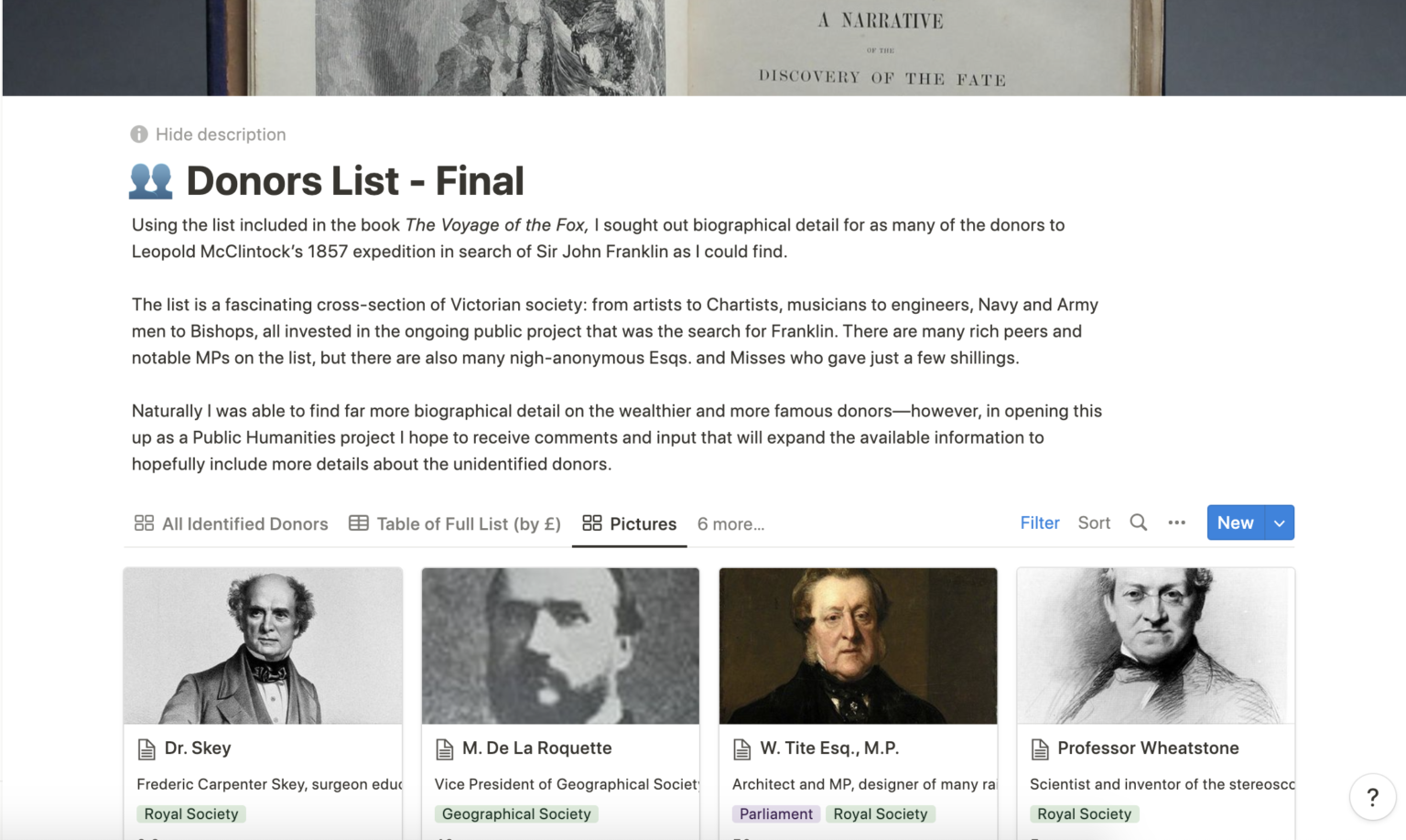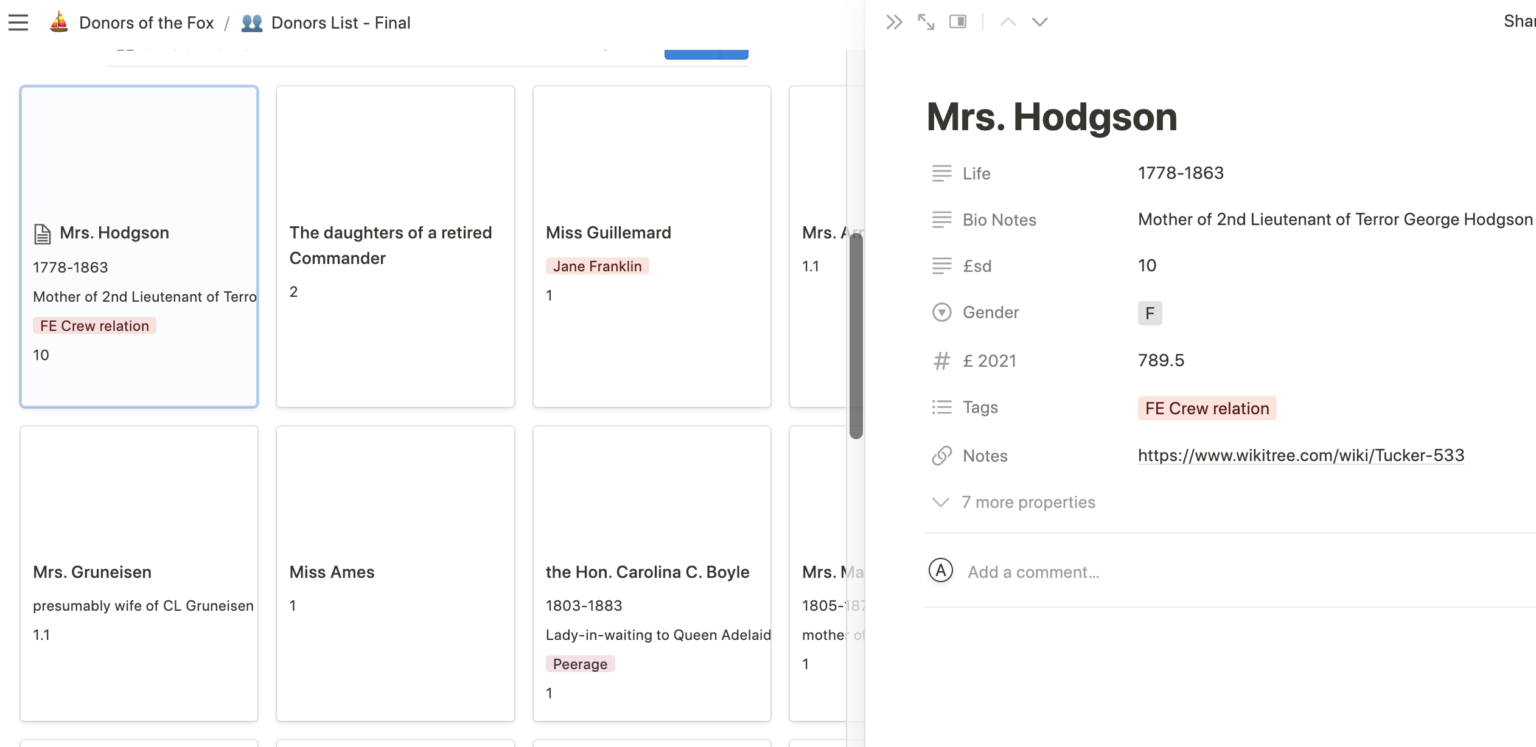This summer, I was the recipient of the generous Digital Humanities Fellowship from NYU. My proposed project was a broad-reaching initiative called “Visualizing the Victorian Polar Network,” but once the fellowship began I quickly realized I had to narrow my view, and ended up settling on a revised version of my project where I would create an interactive, annotated biographical database of all of the donors to Leopold McClintock’s 1857 Franklin search expedition, spearheaded by Lady Jane Franklin as a private expedition to look for her missing husband and his crew after the Admiralty had abdicated all responsibility for the continuing search.
Ever since coming across the appendix in The Voyage of the Fox that listed names like Charles Babbage and William Makepeace Thackeray amongst the donors, I was curious to see what the demographics of the full list were. Why would someone choose to donate money to the search? How many were directly connected to the crew members of the missing expedition, and how many were merely members of the sympathetic public? What were the professions of the donors, their age and gender? And were there any unexpected connections waiting to be discovered?

I conducted research at the Scott Polar Research Institute in Cambridge as well as the British Library in London, where I discovered the connection between a notable Chartist and Terror lieutenant Edward Little, with the Franklins in the middle. That was by far the most interesting thing I came across, but by no means the only one.
After some polishing and organizing, I’ve finally made the whole table accessible to the public on my Notion site:

Interesting stuff
- The names of 37 women appear on this list, including one which appears in the same entry as her husband.
- Average year of birth is 1805, or 52-54 at time of donation.
- The most donated was £500 by Allen Young, who is listed only as “A commander in the Merchant Service.” The second-most, £150, was donated by Lieutenant J. Walter Fairholme’s mother, who was the daughter of Lord Forbes.
- 11 men associated with the Franklin Search donated, including a young Clements Markham (his mother also donated). 15 members of the Royal Society donated, including J.D. Hooker, who had known Crozier on the Antarctic expedition.
- In addition to Babbage, Thackeray, and Julian Harney, some other notables who I discovered had donated including Lady Trevelyan, an artistic patroness associated with the Pre-Raphaelites; Professor Wheatstone, inventor of the Playfair Cipher; Robert Stephenson, who some call the greatest engineer of the 19th century; the diplomat and explorer Lord Dufferin; P.M. Roget, publisher of the thesaurus and erstwhile suitor of Lady Franklin; influencer of Marx and friend of Keats C.W. Dilke; and the aeronaut Rob Hollond.
I encourage you to explore the database yourself and discover more connections!
Edit, 12/8:
After sharing the project in the Remembering the Franklin Expedition Facebook group, some new connections came to light, emphasizing the value of the collaborative nature of a public digital humanities project:
- Logan Zachary of Illuminator identified a connection between the Trevelyans and the Franklin Expedition, via their association with Franklin search-adjacent crackpot William Parker Snow, who solicited the rich couple for money to fund his own searches. That was in 1860, however, after the return of the Fox, so it is clear based on their earlier donation that another link might be found.
- Independent Franklin scholar Karin Lach proposed a possible identification for “Mrs. Arnold,” who donated £1.1: Mary Penrose Arnold, the mother of Matthew Arnold, a student of Sir John Franklin’s son-in-law John Philip Gell. The Arnolds were connected to the Franklins from their time in Van Diemen’s Land (Tasmania).
How to navigate:
You can use the “filters” menu to look at the dataset using different pre-made filters:

As you can see, I’ve made it easy to sort to all the donors with pictures, all the female donors, and all the donors connected to the Franklin Search and the Royal Society with just one click.
To open up an individual’s page, click their name. This will open up their individual database page either on top or to the side of the database. Most if not all of these pages are empty of everything other than their applicable data fields, a picture (if they have one), but if you have any details to suggest or add, you should be able to do so in the comments field.

Lastly, if you would like to view the data in some way which doesn’t already have an existing filter view, you can do so by numerous methods. Navigate to the “Full List” tab, click the “Sort” and/or “Filter” buttons in the upper right, and you can add to or change the existing £ filter, add a filter to the existing one, or make a new sort.

Read more about Visualizing the Victorian Polar Network and other projects funded by the NYU DH Graduate Fellowship program.
